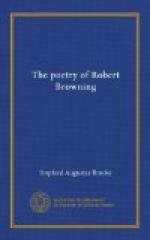The scenery of the poem is as usual clear. We are in fifteenth-century Florence at night. There is no set description, but the slight touches are enough to make us see the silent lonely streets, the churches, the high walls of the monastic gardens, the fortress-palaces. The sound of the fountains is in our ears; the little crowds of revelling men and girls appear and disappear like ghosts; the surly watch with their weapons and torches bustle round the corner. Nor does Browning neglect to paint by slight enlivening touches, introduced into Lippo Lippi’s account of himself as a starving boy, the aspect by day and the character of the Florence of the fifteenth century. This painting of his, slight as it is, is more alive than all the elaborate descriptions in Romola.
As to the poem itself, Browning plunges at once into his matter; no long approaches, no elaborate porches belong to his work. The man and his character are before us in a moment—
I am poor brother Lippo, by
your leave!
You need not clap your torches
to my face.
Zooks, what’s to blame?
You think you see a monk!
What, ’tis past midnight,
and you go the rounds,
And here you catch me at an
alley’s end
Where sportive ladies leave
their doors ajar?
For three weeks he has painted saints, and saints, and saints again, for Cosimo in the Medici Palace; but now the time of blossoms has come. Florence is now awake at nights; the secret of the spring moves in his blood; the man leaps up, the monk retires.
Ouf! I leaned out of
window for fresh air.
There came a hurry of feet
and little feet,
A sweep of lute-strings, laughs
and whifts of song,—
Flower o’
the broom.
Take away love,
and our earth is a tomb!




